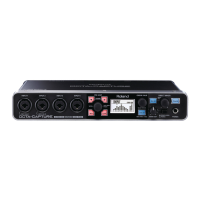28
Playing Back the Sample Data
Here we will play back sample data using the standard functionality provided by your operating
system. The sample data “TTears(.mp3)” is in the included Driver CD-ROM.
981b
* Use of the song data supplied with this product for any purpose other than private, personal
enjoyment without the permission of the copyright holder is prohibited by law. Additionally, this
data must not be copied, nor used in a secondary copyrighted work without the permission of
the copyright holder.
1. Insert the included Driver CD-ROM into the DVD-ROM drive of your computer.
2. From the Sample folder of the CD-ROM, copy the le TTears(.mp3) to your desktop.
3. Play back the sample data “TTears”(.mp3).
Double-click the TTears(.mp3) le you copied to your desktop.
If you’re using Windows, Windows Media Player will start. If you’re using Macintosh, iTunes will start.
Click the play button, and the sample data will start playing.
* Depending on your system, other playback software may start up. If so, play the sample data as
described in the documentation for the software you’re using.
4. Adjust the volume.
Use the OCTA-CAPTURE’s [MAIN OUT] Knob to adjust the volume.
You should hear the sample data played from the headphones or speakers connected to the
OCTA-CAPTURE.
Did you hear the sample data?
If you could hear the sample data, the OCTA-CAPTURE is correctly connected to your
computer and the driver has been installed correctly.
If you could not hear the sample data, refer to “Problems with Playback or Recording”
(p. 85). If there’s no sound, or if there’s something wrong with the playback, information
provided in that section will help you solve the problem.
You’ve nished connecting the OCTA-CAPTURE and installing the driver.
Proceed to one of the following sections, depending on what you want to do next.
For details on settings and operation, refer to “Basic Operation” (p. 29).
If you’ll be using the OCTA-CAPTURE with your DAW software, make the appropriate settings for the
audio port names listed on page “Device Name (Windows)” (p. 81).
“Recording a Microphone or Guitar” (p. 35)
“Simultaneously Recording Multiple Inputs (Multi Recording)” (p. 40)
“Live Set-up with Four Stage Monitors” (p. 62)
“Connecting Two OCTA-CAPTURE Units” (p. 63)

